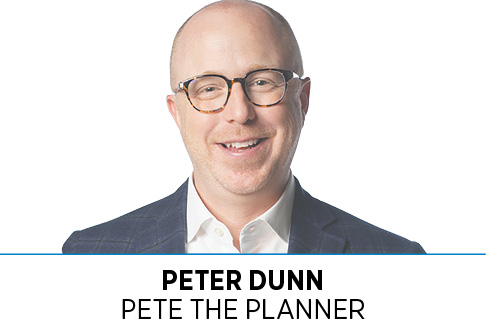Subscriber Benefit
As a subscriber you can listen to articles at work, in the car, or while you work out. Subscribe Now Dear Pete,
Dear Pete,
I’m considering retiring this fall after a 40-year law career. I think I have the correct amount of money saved, but one never really knows. I plan on waiting to take Social Security for a couple of more years, but that might change depending on the stock market. As it stands now, my biggest concern is about what happens to the stock market between now and the first couple years of my retirement. If it trends down, I fear it could have a huge impact on my long-term stability. Is there any way to mitigate that risk?
—Lawrence, McCordsville
Congratulations, Lawrence. You must be equal parts excited, proud and understandably nervous. And while there is quite a bit of volatility in the markets right now, there are a few solutions to ease your market concerns.
Whether you know it or not, your challenge revolves around something called sequence of returns risk. As you’ve grown to know, the market has its ups and downs. And whether you care to acknowledge this or not, the order in which the ups and downs occur hasn’t previously mattered to you because you’ve been in the accumulation phase of your investing experience. When you switch to the distribution phase, the sequence of returns actually matters, and that’s why there’s something called sequence of returns risk.
While your portfolio might have averaged 8% or so in the last few decades, it’s how you continue to get to that 8% average (or any other number) in the next few years that can cause heartburn. For instance, you wouldn’t mind if the next three years produced 8%, 8% and 8%, but that never really happens unless you’re in some sort of fixed-rate investment. You also wouldn’t mind a 12%, 0%, and 12% three-year run. However, a -8%, 2% and 30% could cause some serious challenges if you don’t prepare for them. All three of the above sequence of returns produce different outcomes, and despite getting 30% in the third year of the third scenario, the first-year decline of -8% will leave that particular portfolio sunk.
Now that you understand specifically what you’re trying to avoid, let’s examine a few ways you can do so.
The first two are usually the choices people don’t like, but I happen to believe them to be the most prudent. Delay retirement if the market is falling when your retirement date is approaching. This is not a fun idea, and it can really sour the end of an otherwise lovely career. However, it’s incredibly prudent because it gives your investments a chance to recover before drawing on them, and you can continue making new investments into a depressed market.
The second technique involves decreasing your investment withdrawal rate in a declining market. For example, if your plan has you withdrawing 4% from your portfolio annually, and the market is falling significantly, decrease your withdrawal rate to 2% or so. Again, this isn’t always the most exciting way to begin retirement, but it’s practical. You can always supplement your income during this time frame in various other ways.
The other element to consider here is how your portfolio should shift, in terms of risk, as you enter the distribution phase of your life. I will leave it to professional investment advisers in regard to specificity here, but just know you’re unlikely to have the same portfolio construction as a working person and as a retired person.
My preferred way to address this problem is to assign a portion of your portfolio to solve it. This idea can work in several ways. You could have a pool of cash (equivalents) that aren’t subject to market risks, and you can draw on them when the market is struggling. You could also design a mini portfolio with a two–to-three-year time horizon, designed specifically to withstand a market cycle.
There’s one thing you absolutely cannot do, and that’s ignore your portfolio when it dives in your first year of retirement. Without a doubt, retirement is scary, but burying your head in the sand in the first couple of years is often an unrecoverable mistake. The next time you talk to your financial adviser, ask her how she’s preparing you for sequence of returns risk. If she has a specific plan, understand it, then execute it. If she doesn’t have a plan, it’s time to develop a plan.•
__________
Dunn is CEO of Your Money Line powered by Pete the Planner, an employee-benefit organization focused on solving employees’ financial challenges. Email your financial questions to askpete@petetheplanner.com.
Please enable JavaScript to view this content.
